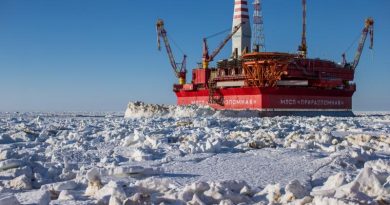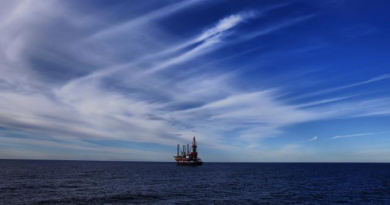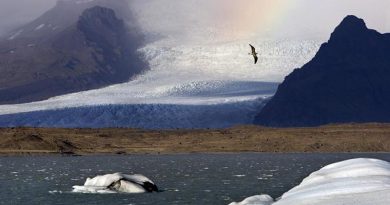Norwegian company looks to Alaska for Arctic shipping port

A Norwegian shipping company is considering using a yet-to-be-determined Western Alaska port as a hub for growing commerce in the Arctic Ocean, Lt. Gov. Mead Treadwell said Tuesday.
Tschudi Shipping Company, a privately-held shipper already doing brisk business in northern waters off Norway and Russia, is eyeing Alaska as a potential location for a transshipment site — that is, a point where cargo would be transferred or a stop could be made on a longer journey — to support existing business to and from its facilities at Kirkenes, Norway, in the Northern Sea Route, Treadwell said.
Felix Tschudi, the company’s chief executive, has approached state officials with his intentions to use an as-yet-undetermined Alaska site to help coordinate shipments of goods and commodities through the Northern Sea Route, said Treadwell, who serves as the state government’s lead representative to the eight-member Arctic Council, an intergovernmental group dedicated to determining and evaluating international Arctic policy.
Tschudi is interested in expanding shipments, as well as in Alaska’s potential supporting role in a type of commerce expected to continue growing as Arctic sea ice recedes, Treadwell said.
“He tends to be one of the most forward-thinking shippers in the Arctic,” Treadwell said.
Tschudi is co-founder of the Centre for High North Logistics, a foundation devoted to research and information exchanges concerning Arctic shipping issues.
Logical sites for Tschudi’s transshipment operations would be Unalaska/Dutch Harbor, already a major cargo port serving vessels traveling between the U.S. West Coast and Asia, and Adak, another well-developed port in the Aleutians, Treadwell said. Both have the advantage of deep water, he said.
Potential competitors with Alaska for Tschudi’s business are ports in Russia and Japan, he said.
Trans-Arctic shipping
In a statement issued by Treadwell’s office, Tschudi said he appreciated Alaska’s official efforts to participate in the growing trans-Arctic shipping business, including an ongoing University of Alaska and state Department of Commerce study of economic spinoffs that could result from an increase in Arctic shipping traffic.
“We are pleased that Alaska sees the economic value of this kind of collaboration, and we will be working to study all possibilities and options in the coming months,” Tschudi said in the statement.
While Unalaska or Adak could be used by Tschudi’s company to coordinate shipments of goods and commodities between Europe and Asia, those sites are hundreds of miles from the Arctic.
That leaves them out of consideration for a deepwater Arctic Alaska port that government officials believe is needed to provide a site of refuge for distressed or weathered-in vessels operating in the region, as well as a delivery point for ships serving oil or mining operators.
Several sites considered
Separately from the work to promote Alaska as a Northern Sea Route transshipment site, the U.S. Army Corps of Engineers and Alaska Department of Transportation and Public Facilities are jointly examining 14 Northern and Western Alaska sites as potential deepwater ports. In a draft report issued in March, a handful of sites emerged as the most likely contenders:
• Port Clarence, about 70 miles northwest of Nome. The port, on a spit extending from the mainland, was home to a U.S. Coast Guard navigational station that operated for 48 years, housing about two dozen personnel during its operational life. The site was closed in 2010, part of the Coast Guard’s phase-out of all its LORAN stations in an era of GPS technology, but most of the facilities — an airstrip, housing, maintenance shop and other buildings — remain intact.
• Nome, which features benefits similar to those at Port Clarence — proximity to infrastructure, as well as proximity to mining prospects. Like Port Clarence, it is perched along the Bering Strait, though its water depths are not as attractive, according to the draft report.
• Barrow, the northernmost community in Alaska, which offers proximity to North Slope oil operations and plentiful infrastructure. Ships coming to Barrow will have the benefit of shelter provided by barrier islands, but the site has relatively shallow waters.
• Cape Darby, an uninhabited site located between Golovin and Elim on the Bering Sea coast. The site has the advantage of natural deep waters and proximity to several mining prospects in active exploration, but it lacks community facilities or infrastructure.
Federal and state agencies have yet to formally announce a preferred location. But there appears to be momentum for a mainland site near the Bering Strait, such as Port Clarence, the draft report’s frontrunner.
This year, the Coast Guard based its Arctic Alaska operations out of Kotzebue, and conducted its 2013 Arctic Shield exercises from there. In July, the Coast Guard, Alaska Department of Environmental Conservation and Canadian Coast Guard used the Port Clarence area to test skimming equipment that would be used for oil spill cleanup.
Contact Yereth Rosen at yereth(at)alaskadispatch.com



